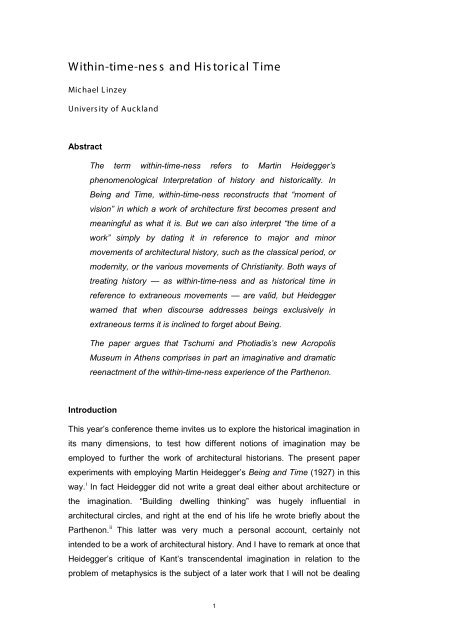Within-time-ness and history.pdf - ResearchSpace@Auckland
Within-time-ness and history.pdf - ResearchSpace@Auckland
Within-time-ness and history.pdf - ResearchSpace@Auckland
You also want an ePaper? Increase the reach of your titles
YUMPU automatically turns print PDFs into web optimized ePapers that Google loves.
<strong>Within</strong>-<strong>time</strong>-nes s <strong>and</strong> His torical Time<br />
Michael Linzey<br />
Univers ity of Auckl<strong>and</strong><br />
Abstract<br />
The term within-<strong>time</strong>-<strong>ness</strong> refers to Martin Heidegger’s<br />
phenomenological Interpretation of <strong>history</strong> <strong>and</strong> historicality. In<br />
Being <strong>and</strong> Time, within-<strong>time</strong>-<strong>ness</strong> reconstructs that “moment of<br />
vision” in which a work of architecture first becomes present <strong>and</strong><br />
meaningful as what it is. But we can also interpret “the <strong>time</strong> of a<br />
work” simply by dating it in reference to major <strong>and</strong> minor<br />
movements of architectural <strong>history</strong>, such as the classical period, or<br />
modernity, or the various movements of Christianity. Both ways of<br />
treating <strong>history</strong> — as within-<strong>time</strong>-<strong>ness</strong> <strong>and</strong> as historical <strong>time</strong> in<br />
reference to extraneous movements — are valid, but Heidegger<br />
warned that when discourse addresses beings exclusively in<br />
extraneous terms it is inclined to forget about Being.<br />
The paper argues that Tschumi <strong>and</strong> Photiadis’s new Acropolis<br />
Museum in Athens comprises in part an imaginative <strong>and</strong> dramatic<br />
reenactment of the within-<strong>time</strong>-<strong>ness</strong> experience of the Parthenon.<br />
Introduction<br />
This year’s conference theme invites us to explore the historical imagination in<br />
its many dimensions, to test how different notions of imagination may be<br />
employed to further the work of architectural historians. The present paper<br />
experiments with employing Martin Heidegger’s Being <strong>and</strong> Time (1927) in this<br />
way. i In fact Heidegger did not write a great deal either about architecture or<br />
the imagination. “Building dwelling thinking” was hugely influential in<br />
architectural circles, <strong>and</strong> right at the end of his life he wrote briefly about the<br />
Parthenon. ii This latter was very much a personal account, certainly not<br />
intended to be a work of architectural <strong>history</strong>. And I have to remark at once that<br />
Heidegger’s critique of Kant’s transcendental imagination in relation to the<br />
problem of metaphysics is the subject of a later work that I will not be dealing<br />
1















